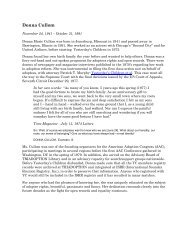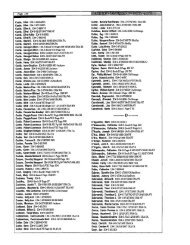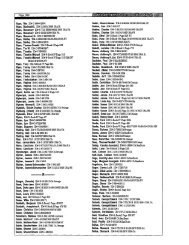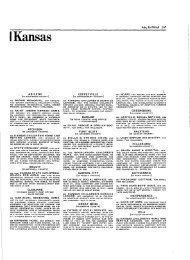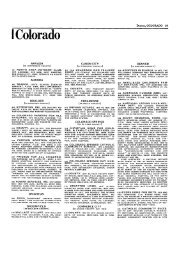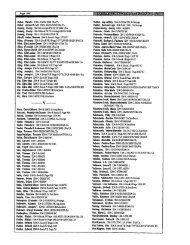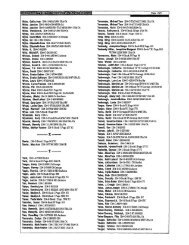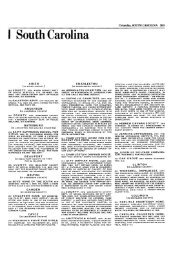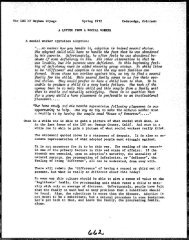TRIADOPTION ® Library, Inc. - CA ~ Pg 369-480
TRIADOPTION ® Library, Inc. - CA ~ Pg 369-480
TRIADOPTION ® Library, Inc. - CA ~ Pg 369-480
Create successful ePaper yourself
Turn your PDF publications into a flip-book with our unique Google optimized e-Paper software.
Where From<br />
3<br />
Five mill'ion people in the United<br />
States today were born with a dual<br />
identity. They are not schizophrenics,<br />
amnesiacs, escapists or mentally unfit.<br />
They are individuals born with two sets<br />
of parents, genetic and adoptive.<br />
An individual carries twenty to twentyfive<br />
thousand genes transmitted to him by<br />
his biological parents and their combined<br />
total ancestry. When a person is separated<br />
from the people who gave him these inheri<br />
ted traits and is placed with a set of<br />
parents of a different ancestral heritage,<br />
he is immediately given by this set of<br />
circumstances, a dual identity.<br />
The heredity factors an infant or child<br />
brings with him into his new environment<br />
dictate his internal reaction to external<br />
influences. Heredity and environment join<br />
to form the individual he wi 11 become.<br />
How the individual copes with life is as<br />
much determined from the moment of his<br />
conception as it is by the surroundings<br />
in which he is placed. As he matures, the<br />
adoptee 1 ives within a nucleus of height- '<br />
ened stress because of acute awareness of<br />
his dual identity.<br />
Can the adoptee's dual identity be<br />
prevented? Our law makers could take the<br />
first step to answer this question by<br />
voting to unseal the birth records of<br />
adoptees. Working with the laws of today,<br />
legislators at the state level are responsible<br />
for a change in the law.<br />
A second step toward the prevention of<br />
dual identity in the adopted infant or<br />
child is "open adoption". "Open adoption"<br />
a1 1 ows adoptive parents and bi rth parents<br />
the option of choosing to know each other<br />
in the adoption of an infant. "Open adoption"<br />
could allow the birth parent,<br />
adoptive parent and the adoptee the choice<br />
of knowi~g one another if, at the time<br />
of his adoption, the adoptee is older.<br />
According to Dr. T Berry Braze1 ton in<br />
hi s col umn in April , 1979, issue of Redbook<br />
Magazine, it is harder work to<br />
raise an adopted child than it is to<br />
raise your own. Adoption carries longer<br />
periods of adjustment between infant<br />
or child and the new parents. When the<br />
natural rhythm and balance of 1 ife change,<br />
as in the moving or placement of a baby<br />
or child, often suddenly, into the lives<br />
R R rn I..<br />
3 ,'<br />
Where To m . . .,<br />
of adoptive parents, however wi 1'I ing,<br />
there is an emotional adjustment to be<br />
made for every member of the new family.<br />
.. ..<br />
he present sealed record laws can only<br />
breed mistrust between adoptive parent and<br />
child, and between adoptee and society as .<br />
a whole. Lack of truth and knowledge in<br />
childhood, and many years of living with<br />
fantasies, can cause numerous frustrations<br />
and personal i ty defects. Certainly, feel ings<br />
of insecurity and ambi valance dominate the<br />
personality of any individual who lives<br />
within a vacuum of who he is and how he got<br />
there.<br />
United States laws are throwing a double<br />
barreled burden on adoptive parents by<br />
enveloping their family relationships with<br />
secrecy. To be eligible to become an adoptive<br />
parent, one must lay bare to strangers<br />
his emotional, financial and sexual stability<br />
If the application to adopt is accepted,<br />
then the adoptive parent or parents are<br />
asked by the agencies to rear their child<br />
without the knowledge to share who, what,<br />
where, when, why and how he came to be.<br />
Primary prevention is the medical and<br />
clinical profession's basis for all research.<br />
Adopti ve parents, the nuhturing<br />
parents, are rearing their chi ldren without<br />
knowledge of his genetic and medical<br />
background. Therefore, they are arbi trari 1y<br />
forced to be unable to prevent the preventab1<br />
e, medi cal ly and emotional ly , as thei r<br />
child is growing up.<br />
Depending on their own individual<br />
maturity, all children face an identity<br />
crisis. Parents often talk about the teen<br />
years as the years when their children<br />
are searching for self-identity. As the<br />
parents of three children, my husband and<br />
I agree we could not have survived without<br />
Dr. Spock and Erman Bombeck!<br />
Dr. Rollo May, a practicing psychoanalyst,<br />
author and lecturer, suggests that<br />
the AGE of TWO is a natural time for the<br />
infant child to enter a stage of rebellion<br />
and try to become free to establish inner<br />
strength! Most psycho1 ogists today agree<br />
that by age six a person's self-image is<br />
basi cal ly formed. Furthermore, the professional's<br />
agree that an individual's method<br />
of operating in life is based on this early<br />
image, whether it be poor, excellent, or<br />
somewhere inbetween, unti 1 he chooses,<br />
through learning and growth, to change.<br />
. ..--.--.. ....--<br />
.





